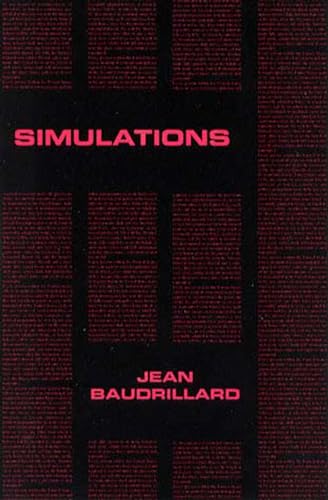simulations de baudrillard jean (35 résultats)
Filtres de recherche
Type d'article
- Tous les types de produits
- Livres (35)
- Magazines & Périodiques (Aucun autre résultat ne correspond à ces critères)
- Bandes dessinées (Aucun autre résultat ne correspond à ces critères)
- Partitions de musique (Aucun autre résultat ne correspond à ces critères)
- Art, Affiches et Gravures (Aucun autre résultat ne correspond à ces critères)
- Photographies (Aucun autre résultat ne correspond à ces critères)
- Cartes (Aucun autre résultat ne correspond à ces critères)
- Manuscrits & Papiers anciens (Aucun autre résultat ne correspond à ces critères)
Etat En savoir plus
Reliure
- Toutes
- Couverture rigide (Aucun autre résultat ne correspond à ces critères)
- Couverture souple (34)
Particularités
- Ed. originale (Aucun autre résultat ne correspond à ces critères)
- Signé (Aucun autre résultat ne correspond à ces critères)
- Jaquette (Aucun autre résultat ne correspond à ces critères)
- Avec images (10)
- Sans impressions à la demande (35)
Langue (2)
Livraison gratuite
Pays
Evaluation du vendeur
-
Etat : good. A copy that has been read, remains in good condition. All pages are intact, and the cover is intact. The spine and cover show signs of wear. Pages can include notes and highlighting and show signs of wear, and the copy can include "From the library of" labels or previous owner inscriptions. 100% GUARANTEE! Shipped with delivery confirmation, if you're not satisfied with purchase please return item for full refund. Ships via media mail.
-
Etat : Very Good. Item in very good condition! Textbooks may not include supplemental items i.e. CDs, access codes etc.
-
EUR 7,59
EUR 4,30 expédition vers Etats-UnisQuantité disponible : Plus de 20 disponibles
Ajouter au panierpaperback. Etat : Fine.
-
EUR 8,87
EUR 3,44 expédition vers Etats-UnisQuantité disponible : 1 disponible(s)
Ajouter au panierEtat : acceptable. Supports Goodwill of Silicon Valley job training programs. The cover and pages are in Acceptable condition! Any other included accessories are also in Acceptable condition showing use. Use can include some highlighting and writing, page and cover creases as well as other types visible wear such as cover tears discoloration, staining, marks, scuffs, etc. All pages intact.
-
EUR 10,19
EUR 2,28 expédition vers Etats-UnisQuantité disponible : 18 disponible(s)
Ajouter au panierEtat : New.
-
EUR 12,54
Gratuit expédition vers Etats-UnisQuantité disponible : Plus de 20 disponibles
Ajouter au panierEtat : New.
-
EUR 12,57
Gratuit expédition vers Etats-UnisQuantité disponible : Plus de 20 disponibles
Ajouter au panierPaperback. Etat : New.
-
EUR 10,76
EUR 2,28 expédition vers Etats-UnisQuantité disponible : 18 disponible(s)
Ajouter au panierEtat : As New. Unread book in perfect condition.
-
EUR 13,12
Gratuit expédition vers Etats-UnisQuantité disponible : Plus de 20 disponibles
Ajouter au panierEtat : As New. Unread copy in mint condition.
-
EUR 14,03
Gratuit expédition vers Etats-UnisQuantité disponible : 1 disponible(s)
Ajouter au panierPaperback. Etat : new. Paperback. Simulations never existed as a book before it was "translated" into English. Actually it came from two different bookCovers written at different times by Jean Baudrillard. The first part of Simulations, and most provocative because it made a fiction of theory, was "The Procession of Simulacra." It had first been published in Simulacre et Simulations (1981). The second part, written much earlier and in a more academic mode, came from L'Echange Symbolique et la Mort (1977). It was a half-earnest, half-parodical attempt to "historicize" his own conceit by providing it with some kind of genealogy of the three orders of appearance: the Counterfeit attached to the classical period; Production for the industrial era; and Simulation, controlled by the code. It was Baudrillard's version of Foucault's Order of Things and his ironical commentary of the history of truth. The book opens on a quote from Ecclesiastes asserting flatly that "the simulacrum is true." It was certainly true in Baudrillard's book, but otherwise apocryphal.One of the most influential essays of the 20th century, Simulations was put together in 1983 in order to be published as the first little black book of Semiotext(e)'s new Foreign Agents Series. Baudrillard's bewildering thesis, a bold extrapolation on Ferdinand de Saussure's general theory of general linguistics, was in fact a clinical vision of contemporary consumer societies where signs don't refer anymore to anything except themselves. They all are generated by the matrix.In effect Baudrillard's essay (it quickly became a must to read both in the art world and in academe) was upholding the only reality there was in a world that keeps hiding the fact that it has none. Simulacrum is its own pure simulacrum and the simulacrum is true. In his celebrated analysis of Disneyland, Baudrillard demonstrates that its childish imaginary is neither true nor false, it is there to make us believe that the rest of America is real, when in fact America is a Disneyland. It is of the order of the hyper-real and of simulation. Few people at the time realized that Baudrillard's simulacrum itself wasn't a thing, but a "deterrence machine," just like Disneyland, meant to reveal the fact that the real is no longer real and illusion no longer possible. But the more impossible the illusion of reality becomes, the more impossible it is to separate true from false and the real from its artificial resurrection, the more panic-stricken the production of the real is. "Simulations" never existed as a book before it was "translated" into English. Actually it came from two different bookCovers written at different times by Jean Baudrillard. The first part of "Simulations," and most provocative because it made a fiction of theory, was "The Procession of Simulacra." It had first been published in "Simulacre et Simulations" (1981). The second part, written much earlier and in a more academic mode, came from "L'Echange Symbolique et la Mort" (1977). It was a half-earnest, half-parodical attempt to "historicize" his own conceit by providing it with some kind of genealogy of the three orders of appearance: the Counterfeit attached to the classical period; Production for the industrial era; and Simulation, controlled by the code. It was Baudrillard's version of Foucault's "Order of Things" and his ironical commentary of the history of truth. The book opens on a quote from Ecclesiastes asserting flatly that "the simulacrum is true." It was certainly true in Baudrillard's book, but otherwise apocryphal. One of the most influential essays of the 20th century, "Simulations" was put together in 1983 in order to be published as Shipping may be from multiple locations in the US or from the UK, depending on stock availability.
-
EUR 8,82
EUR 6,88 expédition vers Etats-UnisQuantité disponible : 1 disponible(s)
Ajouter au panierEtat : very_good. This books is in Very good condition. There may be a few flaws like shelf wear and some light wear.
-
EUR 12,39
EUR 3,44 expédition vers Etats-UnisQuantité disponible : 2 disponible(s)
Ajouter au panierPaper Back. Etat : New.
-
EUR 13,48
EUR 3,44 expédition vers Etats-UnisQuantité disponible : 3 disponible(s)
Ajouter au panierEtat : New. pp. [x] + 159 + [v].
-
EUR 13,37
EUR 3,73 expédition depuis Royaume-Uni vers Etats-UnisQuantité disponible : 15 disponible(s)
Ajouter au panierPAP. Etat : New. New Book. Delivered from our UK warehouse in 4 to 14 business days. Established seller since 2000.
-
EUR 15,15
EUR 3,67 expédition vers Etats-UnisQuantité disponible : 1 disponible(s)
Ajouter au panierEtat : Good. [ No Hassle 30 Day Returns ][ Ships Daily ] [ Underlining/Highlighting: NONE ] [ Writing: NONE ] [ Edition: First ] Publisher: Semiotext(e) Pub Date: 1/1/1983 Binding: Paperback Pages: 169 First edition.
-
EUR 14,66
EUR 7,37 expédition depuis Royaume-Uni vers Etats-UnisQuantité disponible : 3 disponible(s)
Ajouter au panierEtat : New. pp. [x] + 159 + [v].
-
Simulations
Edité par The MIT Press Bookstore Autonomedia, 1983
ISBN 10 : 0936756020 ISBN 13 : 9780936756028
Langue: anglais
Vendeur : Biblios, Frankfurt am main, HESSE, Allemagne
EUR 15,25
EUR 9,95 expédition depuis Allemagne vers Etats-UnisQuantité disponible : 3 disponible(s)
Ajouter au panierEtat : New. pp. [x] + 159 + [v].
-
EUR 12,38
EUR 13,59 expédition depuis Royaume-Uni vers Etats-UnisQuantité disponible : Plus de 20 disponibles
Ajouter au panierEtat : New. In English.
-
Simulations (Foreign Agents Series)
Vendeur : Kennys Bookshop and Art Galleries Ltd., Galway, GY, Irlande
EUR 15,79
EUR 10,50 expédition depuis Irlande vers Etats-UnisQuantité disponible : Plus de 20 disponibles
Ajouter au panierEtat : New. 1983. Highlighted. Paperback. Baudrillard's bewildering thesis, a bold extrapolation on Ferdinand de Saussure's general theory of general linguistics, is in fact a clinical vision of contemporary consumer societies where signs don't refer anymore to anything except themselves. They all are generated by the matrix. Translator(s): Foos, Paul; Patton, Paul; Beitchman, Philip; Foss, P. Series: Semiotext(e) / Foreign Agents. Num Pages: 169 pages. BIC Classification: HP. Category: (G) General (US: Trade). Dimension: 176 x 114 x 11. Weight in Grams: 140. . . . . .
-
EUR 18,49
EUR 9,06 expédition vers Etats-UnisQuantité disponible : Plus de 20 disponibles
Ajouter au panierEtat : New. 1983. Highlighted. Paperback. Baudrillard's bewildering thesis, a bold extrapolation on Ferdinand de Saussure's general theory of general linguistics, is in fact a clinical vision of contemporary consumer societies where signs don't refer anymore to anything except themselves. They all are generated by the matrix. Translator(s): Foos, Paul; Patton, Paul; Beitchman, Philip; Foss, P. Series: Semiotext(e) / Foreign Agents. Num Pages: 169 pages. BIC Classification: HP. Category: (G) General (US: Trade). Dimension: 176 x 114 x 11. Weight in Grams: 140. . . . . . Books ship from the US and Ireland.
-
EUR 24,99
EUR 3,71 expédition vers Etats-UnisQuantité disponible : 1 disponible(s)
Ajouter au panierPaperback. Etat : new. Excellent Condition.Excels in customer satisfaction, prompt replies, and quality checks.
-
EUR 14,13
EUR 14,21 expédition depuis Royaume-Uni vers Etats-UnisQuantité disponible : Plus de 20 disponibles
Ajouter au panierPaperback / softback. Etat : New. New copy - Usually dispatched within 4 working days.
-
EUR 14,01
EUR 14,68 expédition depuis Royaume-Uni vers Etats-UnisQuantité disponible : 1 disponible(s)
Ajouter au panierEtat : Good. This is an ex-library book and may have the usual library/used-book markings inside.This book has soft covers. In good all round condition. Please note the Image in this listing is a stock photo and may not match the covers of the actual item,200grams, ISBN:0936756020.
-
EUR 13,36
EUR 17,02 expédition depuis Royaume-Uni vers Etats-UnisQuantité disponible : 18 disponible(s)
Ajouter au panierEtat : New.
-
EUR 14,88
EUR 17,02 expédition depuis Royaume-Uni vers Etats-UnisQuantité disponible : 18 disponible(s)
Ajouter au panierEtat : As New. Unread book in perfect condition.
-
EUR 15,87
EUR 19,41 expédition depuis Canada vers Etats-UnisQuantité disponible : 1 disponible(s)
Ajouter au panierSoft cover. Etat : Very Good. MILD SHELF WEAR,CLEAN INTERIOR,NO MARKS OR WRITING,TIGHT, SQUARE,SAME DAY SHIPPING.
-
EUR 26,67
EUR 11,34 expédition depuis Royaume-Uni vers Etats-UnisQuantité disponible : 1 disponible(s)
Ajouter au panierPaperback. Etat : Brand New. highlighted edition. 159 pages. 7.25x4.75x0.25 inches. In Stock.
-
Simulations.
Edité par New York, Semiotext[e], 1988., 1988
Vendeur : Grant's Bookshop, Cheltenham, VIC, Australie
EUR 12,79
EUR 12,89 expédition depuis Australie vers Etats-UnisQuantité disponible : 1 disponible(s)
Ajouter au panier8vo. 164pp. Original wrappers, a very good copy. . In the Foreign Agents series.
-
EUR 17,43
EUR 30,14 expédition depuis Australie vers Etats-UnisQuantité disponible : 1 disponible(s)
Ajouter au panierSoft cover. Etat : As New.
-
EUR 24,72
EUR 31,91 expédition depuis Australie vers Etats-UnisQuantité disponible : 1 disponible(s)
Ajouter au panierPaperback. Etat : new. Paperback. Simulations never existed as a book before it was "translated" into English. Actually it came from two different bookCovers written at different times by Jean Baudrillard. The first part of Simulations, and most provocative because it made a fiction of theory, was "The Procession of Simulacra." It had first been published in Simulacre et Simulations (1981). The second part, written much earlier and in a more academic mode, came from L'Echange Symbolique et la Mort (1977). It was a half-earnest, half-parodical attempt to "historicize" his own conceit by providing it with some kind of genealogy of the three orders of appearance: the Counterfeit attached to the classical period; Production for the industrial era; and Simulation, controlled by the code. It was Baudrillard's version of Foucault's Order of Things and his ironical commentary of the history of truth. The book opens on a quote from Ecclesiastes asserting flatly that "the simulacrum is true." It was certainly true in Baudrillard's book, but otherwise apocryphal.One of the most influential essays of the 20th century, Simulations was put together in 1983 in order to be published as the first little black book of Semiotext(e)'s new Foreign Agents Series. Baudrillard's bewildering thesis, a bold extrapolation on Ferdinand de Saussure's general theory of general linguistics, was in fact a clinical vision of contemporary consumer societies where signs don't refer anymore to anything except themselves. They all are generated by the matrix.In effect Baudrillard's essay (it quickly became a must to read both in the art world and in academe) was upholding the only reality there was in a world that keeps hiding the fact that it has none. Simulacrum is its own pure simulacrum and the simulacrum is true. In his celebrated analysis of Disneyland, Baudrillard demonstrates that its childish imaginary is neither true nor false, it is there to make us believe that the rest of America is real, when in fact America is a Disneyland. It is of the order of the hyper-real and of simulation. Few people at the time realized that Baudrillard's simulacrum itself wasn't a thing, but a "deterrence machine," just like Disneyland, meant to reveal the fact that the real is no longer real and illusion no longer possible. But the more impossible the illusion of reality becomes, the more impossible it is to separate true from false and the real from its artificial resurrection, the more panic-stricken the production of the real is. "Simulations" never existed as a book before it was "translated" into English. Actually it came from two different bookCovers written at different times by Jean Baudrillard. The first part of "Simulations," and most provocative because it made a fiction of theory, was "The Procession of Simulacra." It had first been published in "Simulacre et Simulations" (1981). The second part, written much earlier and in a more academic mode, came from "L'Echange Symbolique et la Mort" (1977). It was a half-earnest, half-parodical attempt to "historicize" his own conceit by providing it with some kind of genealogy of the three orders of appearance: the Counterfeit attached to the classical period; Production for the industrial era; and Simulation, controlled by the code. It was Baudrillard's version of Foucault's "Order of Things" and his ironical commentary of the history of truth. The book opens on a quote from Ecclesiastes asserting flatly that "the simulacrum is true." It was certainly true in Baudrillard's book, but otherwise apocryphal. One of the most influential essays of the 20th century, "Simulations" was put together in 1983 in order to be Shipping may be from our Sydney, NSW warehouse or from our UK or US warehouse, depending on stock availability.











